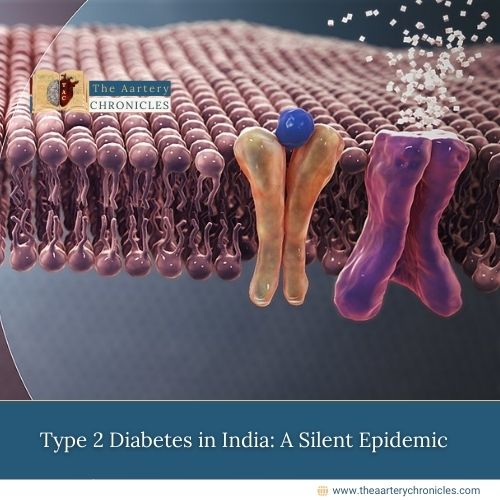

Type 2 Diabetes in India: A Silent Epidemic
Introduction
Type 2 diabetes is a long-lasting health problem that affects how the body controls blood sugar. This happens when the body doesn’t make enough insulin or can’t use insulin properly. Insulin is a hormone that helps sugar from the blood get into cells for energy. When blood sugar levels get too high it can cause many health issues.
Type 2 diabetes, once mostly diagnosed in adults, now affects people of all ages, including children, due to rising obesity rates among younger generations.
While there is no cure for type 2 diabetes, it can be managed through lifestyle changes, medications, and insulin therapy
Causes Of Type 2 diabetes
There are many causal factors for the disease, all of which accumulate in several ways.
- Insulin Resistance: This causes the body’s cells to respond less sensitive to insulin and raise blood glucose.
- Pancreas Function: The pancreas works harder to make sufficient insulin for the body when the pancreas struggles to cope with a high-blood-sugar level.
- Family History: A strong family history of the disease can put someone at risk.
- Excessive Weight: Being overweight, especially around the abdominal area, can lead to an increased chance of developing insulin resistance.
- Inactivity: A sedentary lifestyle contributes to weight gain and decreased insulin sensitivity.
- Diet: The consumption of processed foods and sugary drinks with excessive carbohydrates contributes to elevated blood sugar levels.
- Hormonal Factors: The hormonal disorders such as polycystic ovary syndrome affects insulin sensitivity often.
- Stress and Sleep Problems: Chronic stress levels, as well as poor sleep, impair blood sugar regulation.
Prevalence Of Type 2 diabetes
Type 2 diabetes has become a significant health concern in India, reflecting a growing epidemic that mirrors trends seen across the globe. As of 2019, the International Diabetes Federation (IDF) reported that
- Approximately 77 million individuals in India were living with diabetes, with this number expected to rise to over 134 million by 2045.
- The prevalence among adults was estimated to be about 8.9%, which has seen a marked increase from 7.1%in 2009.
- Alarmingly, around 57% of these cases remain undiagnosed, suggesting a substantial gap in awareness and healthcare access.
Research indicates that the prevalence of diabetes displays significant geographical variation. For instance, urban areas tend to report higher prevalence rates—around 11.2% compared to rural areas, which stand at 5.2%. Moreover, certain states like Tamil Nadu and Chandigarh report particularly high prevalence rates, estimated at 13.7% and 14.2%, respectively. Across the population, the burden of diabetes is notably higher among older adults, with an estimated 12.1 million people aged over 65 living with diabetes as of 2019. This number is projected to increase more than doubling by 2045.
Additionally, the rise of impaired glucose tolerance (IGT) is also a growing concern, with about 25.2 million adults reported to have this prediabetic condition, expected to rise to 35.7 million by 2045.
Incidence Of diabetes
The incidence of diabetes is also on the rise, reflecting a worrying trend of increasing new cases. Longitudinal studies reveal that the incidence rates for diabetes hover around 20 to 30 per 1000 person-years in various population cohorts. For example, the Chennai Urban Population Study reported an incidence rate of 20.2per 1000 person-years for diabetes, while the Chennai Urban Rural Epidemiology Study (CURES) reported an even higher incidence rate of 22.2 per 1000 person-years , alongside rates for prediabetes and any dysglycemia.
In rural areas, the incidence rates indicate a troubling pattern as well. A study conducted in Puducherry noted an incidence rate of 21.5 per 1000 person-years , with a noted increase among men compared to women. Similarly, a study in Kerala found incidence rates of 24.5 per 1000 person-years for type 2 diabetes.
Key Risk Factors
The increasing rates of diabetes are closely linked to
- Lifestyle changes associated with urbanization, such as
- Sedentary behavior
- Unhealthy eating habits
- Rising obesity rates in the population
- Moreover, genetic predisposition along ethnic lines also contributes to the susceptibility observed among South Asians, particularly Indian populations.
On ranking India as the second-highest country globally, following China. This number is projected to soar to 134 million by 2045 . Alarmingly, around 57% of these individuals remain undiagnosed, reflecting significant gaps in healthcare access and public awareness.
The International Diabetes Federation (IDF) reports that the national prevalence of diabetes rose from 7.1% in 2009n to 8.9% in 2019. Various studies indicate significant disparities in prevalence rates based on geography and demographics. For instance, urban areas tend to have higher prevalence compared to rural ones. The Indian Council of Medical Research–INdia DIABetes (ICMR–INDIAB) study highlighted that the prevalence of diabetes ranged from 3.5% to 15.5% in urban settings across different states.
Trends Over Time
The trajectory of diabetes prevalence in India is concerning. The India State-Level Disease Burden Initiative reported a 64.3% increase in prevalence from 1990 to 2016, with diabetes jumping from the 35th leading cause of disability-adjusted life years (DALYs) in 1990 to the 13th in 2016. Notably, certain states such as Tamil Nadu and Kerala exhibit significantly higher prevalence rates, reflecting regional disparities.
Symptoms of Type 2 Diabetes
- Increased thirst:-Feeling unusually thirsty, even when you haven’t been exercising or in hot weather.
- Frequent urination:- Needing to urinate more often than usual, even at night.
- Increased hunger:- Feeling hungry more frequently than normal, even after eating a meal.
- Unintended weight loss:- Losing weight without trying or making changes to your diet or exercise routine.
- Fatigue:- Feeling tired or exhausted, even after getting enough sleep.
- Blurred vision:- Having trouble seeing clearly or experiencing changes in vision
- Slow-healing sores:- Wounds or cuts that take longer to heal than usual.
- Frequent infections:- Experiencing recurrent infections, such as urinary tract infections, skin infections, or yeast infections.
- Numbness or tingling in the hands or feet:- Having a sensation of numbness or tingling in your extremities.
- 10.Areas of darkened skin, usually in the armpits and neck:- Developing dark, velvety patches of skin, often called acanthosis nigricans.
Role of primary health care in prevention of type 2 diabetes
Primary health care plays a crucial role in preventing Type 2 diabetes in India by promoting early detection and supporting healthy lifestyle habits.
- With over 91 million people affected by diabetes in South-East Asia, many are unaware of their condition, leading to severe complications if left untreated.
- Strengthening primary health care helps people
- Recognize symptoms early
- Manage risks
- Access necessary treatments to prevent complications
- Families are central to this approach, as they can encourage healthy habits, such as balanced diets and regular physical activity, which lower diabetes risk.
India’s national health plans are focused on equipping primary care facilities to screen for diabetes, offer quality medicines, and provide educational resources to families. Increasing access to healthy foods, safe exercise spaces, and diabetes awareness can make it easier for individuals to make healthier choices. By emphasizing family involvement and quality health care at the primary level, India is working to control and prevent Type 2 diabetes and improve overall public health.
Conclusion
Type 2 diabetes is a growing epidemic in India, affecting millions of people across all age groups. The rise in cases is closely linked to lifestyle changes, including poor diet and inactivity, as well as genetic predispositions. Primary health care plays an essential role in addressing this issue by promoting early detection, increasing awareness, and supporting families in adopting healthy habits. With improved access to quality primary care, educational resources, and lifestyle modifications, India can better manage and prevent Type 2 diabetes. It’s a challenge that requires both individual commitment and systemic support, but with comprehensive efforts, there’s hope to slow down the prevalence of this disease and reduce its impact on public health.









